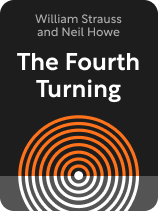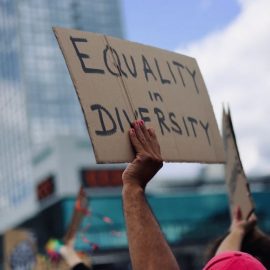

This article is an excerpt from the Shortform book guide to "The Fourth Turning" by William Strauss and Neil Howe. Shortform has the world's best summaries and analyses of books you should be reading.
Like this article? Sign up for a free trial here.
What was the prevailing mood of America after World War II? What was it like for young people? How did society perceive the government?
In The Fourth Turning, historian William Strauss and consultant Neil Howe explain how Anglo-American history follows a pattern of four 15- to 25-year periods, called Turnings, and how the behaviors of different generations define these Turnings. They explain that the First Turning is a High.
Read more to understand First Turnings in general and the most recent First Turning, 1946 to 1964, in particular.
The Four Turnings
If you’ve ever noticed that history seems to repeat itself over the course of centuries, you may be wondering what causes that pattern—and how it may play out in the future. Like a single phase of a human life, a Turning lasts around 15 to 25 years.
A single cycle of these four Turnings is called a saeculum. Turnings aren’t characterized by the events that occur during them but rather by society’s reactions to those events. According to the authors, the First Turning is a High, the Second Turning is an Awakening, the Third Turning is an Unraveling, and the Fourth Turning is a Crisis.
The First Turning
According to the authors, a High occurs after a period of great turmoil is resolved. During a High, a new social order is put in place. Government is strong and active, and public services are expanded. New institutions like schools are established and infrastructure is strengthened. Public trust in these institutions is strong.
Values like individualism fall out of fashion and are replaced by more collective values. This includes an emphasis on self-sacrifice and duty for the greater good of the community, as well as a strong expectation for conformity. Income inequality and unemployment fall, and productivity increases. Class inequality also falls, but gender gaps increase as society’s values begin to reflect a strict division between masculine and feminine roles. Children are given greater autonomy, and parents become less protective.
America’s Most Recent First Turning
The authors published this book in 1997, at which point they explained that the US was nearing the end of a Third Turning. America’s current saeculum began in 1946, just after World War II (America’s most recent Crisis).
The First Turning of our current saeculum lasted from 1946 to 1964, explain the authors. With the Crisis of the war over, the G.I. generation returned from war with renewed optimism and a sense of collective purpose. They were welcomed back home as brave champions and began forming secure, prosperous families.
(Shortform note: The success of the American High depended largely on the Allies’ victory in World War II. Critics before the war cautioned that a loss would result in America being dismantled and taken over by the victors, which would essentially be the end of the American empire. Modern scholars suggest that although there was very little chance of an Allied loss by the time America entered the war, a loss would have resulted in the complete extermination of Jewish people and the large-scale support of Nazis in America. In either case, it would be difficult to term the resulting era a “High” for the general population.)
During this Turning, the elder Lost (Nomad) generation was leading with the wisdom built by living through two world wars and the Great Depression. They willingly and self-sacrificially paid high taxes to support the younger generations. The (Hero) G.I.s in midlife built their nation to its greatest point in history so far. The young adult Silent (Artist) generation married early and avoided risk, working mostly to help the older and younger generations in their efforts rather than pursuing a generational cause of their own.
| Prosperity During a High: Will Millennials Be Left Behind? Experts note a large difference between young adult trajectories in the American High compared to today, which may be attributable to the economic opportunities available to the American High G.I. and Silent generations (that Turning’s midlife and young adult generations, respectively) compared to the opportunities available for today’s young adults, Millennials. Research shows that greater financial stability results in earlier and more common family-building and child-rearing, which explains the huge rise in birth rates that resulted in the Baby Boomer generation (the offspring of the financially successful G.I. and Silent generations). However, today’s experts point out that Millennials are on track to be the most financially disadvantaged generation in American history. Even while Boomers and Xennials (today’s elder and midlife generations) were subject to the same economic recessions as Millennials, Boomer and Xennial wages largely recovered, while Millennials’ did not. This is because the recessions disrupted the early careers of Millennials, knocking them off the traditional trajectory of wage growth and wealth accumulation, which they haven’t been able to make up for. In 2020, despite making up a plurality of the US workforce, Millennials controlled less than 5% of the nation’s wealth. Though a new High should be on its way, experts suggest that Millennials, who will be in the midlife stage at that point, are likely to never recover from the blow to their finances, unlike the previous midlife, Hero generation (G.I.s) who enjoyed great economic prosperity during the American High. |
During the American High, trust in government and institutions was high, and governing power was strong and had plentiful resources to implement social change. Income inequality dropped and the middle class flourished. As families grew, their need for housing increased as well, leading to the mass building of suburbs. However, beneath the upbeat mood of the High, racism and sexism brewed, materialism was rampant, and nonconformity was stigmatized.
(Shortform note: The American High may have actually represented a net loss in opportunity for some marginalized groups, as people who entered the workforce during the war were pushed out again in favor of white men. Black women in particular saw greater economic prosperity during the Crisis, as 600,000 of them took over jobs left by soldiers going to war. However, when the war ended and the soldiers returned home, those women lost those jobs and consequently their income despite their integral role in maintaining American industry during the war.)

———End of Preview———
Like what you just read? Read the rest of the world's best book summary and analysis of William Strauss and Neil Howe's "The Fourth Turning" at Shortform.
Here's what you'll find in our full The Fourth Turning summary:
- How Anglo-American history follows a pattern of four 15 to 25-year periods
- How the behaviors of different generations define these Turnings
- Predictions about the next Turning—a Crisis






